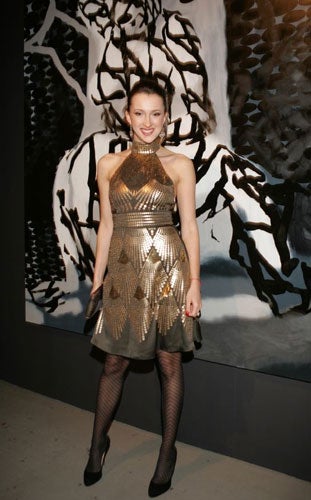Oligart: The heiress selling British works to the Russians

Just a year ago, the sweet smell of chocolate filled the air inside the majestic Red October factory, as millions of bars of Russia's most famous confectionery brand came off the production line.
Now, the chocolate has gone, and the space is hosting an exhibition of some of the hottest young London artists around, bringing new British art to Moscow for the first time. The organisers say the exhibit is a sign both of the changing tastes among Russian gallery-goers and a gradual warming of fraught British-Russian relations.
Attracting as much interest as the art is the gallery's director, Maria Baibakova. A wealthy heiress whose father was a top manager at Russia's Norilsk Nickel metals giant, Ms Baibakova was born in Moscow but educated in the US and Britain, before returning home to set up her gallery.
She's part of a revolution in contemporary art in the Russian capital that is headed by a rich, ambitious set of twenty-somethings. Like Roman Abramovich's girlfriend, Daria Zhukova, who opened a gallery in a disused bus depot last autumn , Ms Baibakova is wealthy, cosmopolitan and speaks English with an American twang. And, at 23, she's even younger than the Chelsea owner's other half.
"This is really something new for Moscow," she said during an impromptu tour of the exhibition last week. Unlike Ms Zhukova, who once declined to name a single artist whom she likes, Ms Baibakova radiated enthusiasm and gushed with praise for the works on display like an eager art student.
Which, until last year, is exactly what she was. She studied art history at Columbia University, graduating in 2007, and then did an MA at the Courtauld Institute of Art in London, finishing last summer. As she bobbed round the gallery, phone in hand, she cut a very different image from the stereotype of rich Russian bling, wearing little makeup, no earrings and a colourful but tasteful Donna Karan dress.
She discovered the venue on a tour to watch chocolate being made. When she found out it was closing, to be turned into luxury housing, she decided to rent out one floor for an art space.
The splendid red brick building was built in the late 19th century and has been a landmark of central Moscow ever since. Located on an island in the Moscow River, just a few hundred metres from the Kremlin but in an area that today feels abandoned and desolate, the luxury housing project has been put on hold as the financial crisis hits Russia hard.
Many of the 22 featured artists were not born in Britain, but they are all London-based. Few are household names in the UK, let alone Russia. Ms Baibakova said she wanted to move on from the shock tactics of the so-called YBAs – the Young British Artists led by Damien Hirst and Tracy Emin, who flourished during the 1990s. The overriding theme is urban life, and the exhibits include a work by Douglas White of burnt-out rubbish bins taken from a British council estate. There is also video and photographic work, and even a light installation that must be climbed into.
"I'm so happy to have got an exhibition of modern British art to Moscow," said Ms Baibakova. "In the past, with relations between Russia and Britain fraught with political difficulties, British art has not been top of the agenda. "There were attempts to bring the Turner Prize retrospective to Moscow at the end of 2007 and it didn't happen for political reasons. The government wasn't keen on showing support for British contemporary art."
But while she might be doing her bit to thaw tensions between London and Moscow, Ms Baibakova is also careful not to go too far. For her gallery's first exhibition late last year, which commissioned a group of upcoming Russian artists to create new works, she expressly banned political themes.
"We asked the artists not to do art for shock value's sake. We asked them to stay away from Putin and Medvedev as themes because we think that although there's a place for that, it's not necessary to include it in every exhibition."
She says that she is simply not interested in political art, both because it places the works into a localised context rather than promoting the internationalisation of art that she is keen to foster, but also because in the Russian context it seems a bit passé.
"It feels like the remnants of the post-Soviet existence, when finally we could say how much we hated the Soviet Union; let's talk about it everywhere. Now that has translated into Putin and Medvedev."
Even though she was only six years old when the Soviet Union fell, her reasoning makes sense, but there is clearly an element of political expediency involved as well. Contemporary art designed to shock is more controversial in Russia than most places, with a number of exhibitions being closed down. In some cases prosecutions have been brought against curators.
Just across the river from Red October are the golden domes of Christ the Saviour Cathedral, the centre of Russian Orthodox Christianity, and a few hundred metres downstream are the spires and turrets of the Kremlin. With such neighbours, avoiding shock art and political art will make life much easier for the gallery.
Ms Baibakova says response to her exhibition has been overwhelming, but not everyone is convinced.
"There is no conceptual framework whatsoever; the only aim is to bring some works over that will please the society crowd," said Ekaterina Degot, a prominent Russian art critic. "I liked nothing about it, even the best pieces are of student quality."
Join our commenting forum
Join thought-provoking conversations, follow other Independent readers and see their replies
Comments